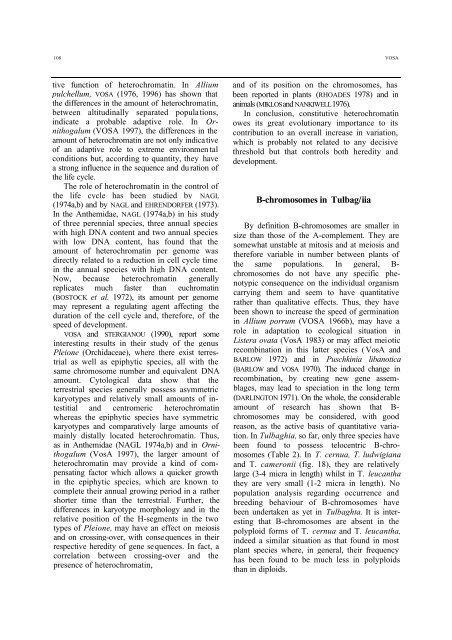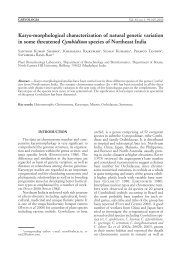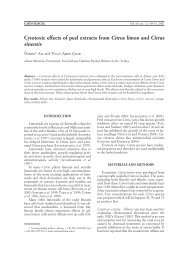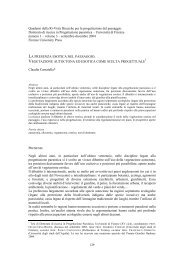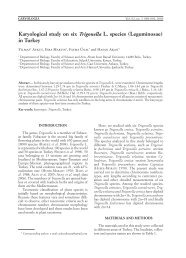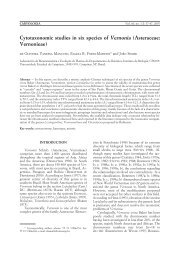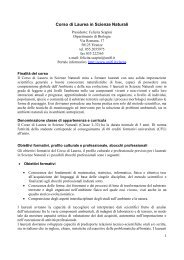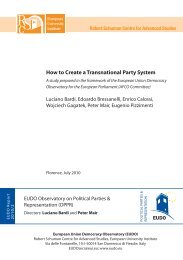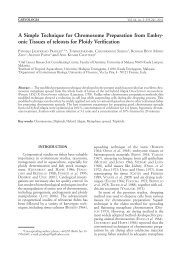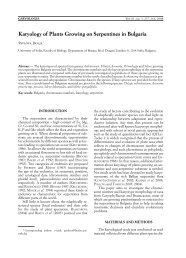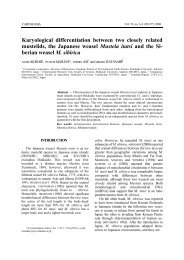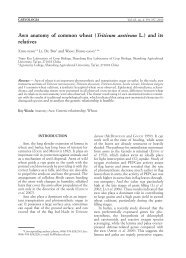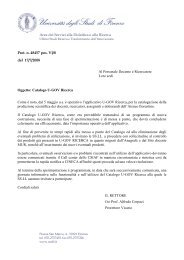A revised cytotaxonomy of the genus Tulbaghia (Alliaceae)
A revised cytotaxonomy of the genus Tulbaghia (Alliaceae)
A revised cytotaxonomy of the genus Tulbaghia (Alliaceae)
Create successful ePaper yourself
Turn your PDF publications into a flip-book with our unique Google optimized e-Paper software.
108 VOSA<br />
tive function <strong>of</strong> heterochromatin. In Allium<br />
pulchellum, VOSA (1976, 1996) has shown that<br />
<strong>the</strong> differences in <strong>the</strong> amount <strong>of</strong> heterochromatin,<br />
between altitudinally separated populations,<br />
indicate a probable adaptive role. In Ornithogalum<br />
(VOSA 1997), <strong>the</strong> differences in <strong>the</strong><br />
amount <strong>of</strong> heterochromatin are not only indicative<br />
<strong>of</strong> an adaptive role to extreme environmen tal<br />
conditions but, according to quantity, <strong>the</strong>y have<br />
a strong influence in <strong>the</strong> sequence and du ration <strong>of</strong><br />
<strong>the</strong> life cycle.<br />
The role <strong>of</strong> heterochromatin in <strong>the</strong> control <strong>of</strong><br />
<strong>the</strong> life cycle has been studied by NAGL<br />
(1974a,b) and by NAGL and EHRENDORFER (1973).<br />
In <strong>the</strong> An<strong>the</strong>midae, NAGL (1974a,b) in his study<br />
<strong>of</strong> three perennial species, three annual species<br />
with high DNA content and two annual species<br />
with low DNA content, has found that <strong>the</strong><br />
amount <strong>of</strong> heterochromatin per genome was<br />
directly related to a reduction in cell cycle time<br />
in <strong>the</strong> annual species with high DNA content.<br />
Now, because heterochromatin generally<br />
replicates much faster than euchromatin<br />
(BOSTOCK et al. 1972), its amount per genome<br />
may represent a regulating agent affecting <strong>the</strong><br />
duration <strong>of</strong> <strong>the</strong> cell cycle and, <strong>the</strong>refore, <strong>of</strong> <strong>the</strong><br />
speed <strong>of</strong> development.<br />
VOSA and STERGIANOU (1990), report some<br />
interesting results in <strong>the</strong>ir study <strong>of</strong> <strong>the</strong> <strong>genus</strong><br />
Pleione (Orchidaceae), where <strong>the</strong>re exist terrestrial<br />
as well as epiphytic species, all with <strong>the</strong><br />
same chromosome number and equivalent DNA<br />
amount. Cytological data show that <strong>the</strong><br />
terrestrial species generally possess asymmetric<br />
karyotypes and relatively small amounts <strong>of</strong> intestitial<br />
and centromeric heterochromatin<br />
whereas <strong>the</strong> epiphytic species have symmetric<br />
karyotypes and comparatively large amounts <strong>of</strong><br />
mainly distally located heterochromatin. Thus,<br />
as in An<strong>the</strong>midae (NAGL 1974a,b) and in Ornithogalum<br />
(VosA 1997), <strong>the</strong> larger amount <strong>of</strong><br />
heterochromatin may provide a kind <strong>of</strong> compensating<br />
factor which allows a quicker growth<br />
in <strong>the</strong> epiphytic species, which are known to<br />
complete <strong>the</strong>ir annual growing period in a ra<strong>the</strong>r<br />
shorter time than <strong>the</strong> terrestrial. Fur<strong>the</strong>r, <strong>the</strong><br />
differences in karyotype morphology and in <strong>the</strong><br />
relative position <strong>of</strong> <strong>the</strong> H-segments in <strong>the</strong> two<br />
types <strong>of</strong> Pleione, may have an effect on meiosis<br />
and on crossing-over, with consequences in <strong>the</strong>ir<br />
respective heredity <strong>of</strong> gene sequences. In fact, a<br />
correlation between crossing-over and <strong>the</strong><br />
presence <strong>of</strong> heterochromatin,<br />
and <strong>of</strong> its position on <strong>the</strong> chromosomes, has<br />
been reported in plants (RHOADES 1978) and in<br />
animals (MIKLOS and NANKIWELL 1976).<br />
In conclusion, constitutive heterochromatin<br />
owes its great evolutionary importance to its<br />
contribution to an overall increase in variation,<br />
which is probably not related to any decisive<br />
threshold but that controls both heredity and<br />
development.<br />
B-chromosomes in Tulbag/iia<br />
By definition B-chromosomes are smaller in<br />
size than those <strong>of</strong> <strong>the</strong> A-complement. They are<br />
somewhat unstable at mitosis and at meiosis and<br />
<strong>the</strong>refore variable in number between plants <strong>of</strong><br />
<strong>the</strong> same populations. In general, Bchromosomes<br />
do not have any specific phenotypic<br />
consequence on <strong>the</strong> individual organism<br />
carrying <strong>the</strong>m and seem to have quantitative<br />
ra<strong>the</strong>r than qualitative effects. Thus, <strong>the</strong>y have<br />
been shown to increase <strong>the</strong> speed <strong>of</strong> germination<br />
in Allium porrum (VOSA 1966b), may have a<br />
role in adaptation to ecological situation in<br />
Listera ovata (VosA 1983) or may affect meiotic<br />
recombination in this latter species (VosA and<br />
BARLOW 1972) and in Puschkinia libanotica<br />
(BARLOW and VOSA 1970). The induced change in<br />
recombination, by creating new gene assemblages,<br />
may lead to speciation in <strong>the</strong> long term<br />
(DARLINGTON 1971). On <strong>the</strong> whole, <strong>the</strong> considerable<br />
amount <strong>of</strong> research has shown that Bchromosomes<br />
may be considered, with good<br />
reason, as <strong>the</strong> active basis <strong>of</strong> quantitative variation.<br />
In <strong>Tulbaghia</strong>, so far, only three species have<br />
been found to possess telocentric B-chromosomes<br />
(Table 2). In T. cernua, T. ludwigiana<br />
and T. cameronii (fig. 18), <strong>the</strong>y are relatively<br />
large (3-4 micra in length) whilst in T. leucantha<br />
<strong>the</strong>y are very small (1-2 micra in length). No<br />
population analysis regarding occurrence and<br />
breeding behaviour <strong>of</strong> B-chromosomes have<br />
been undertaken as yet in Tulbaghta. It is interesting<br />
that B-chromosomes are absent in <strong>the</strong><br />
polyploid forms <strong>of</strong> T. cernua and T. leucantha,<br />
indeed a similar situation as that found in most<br />
plant species where, in general, <strong>the</strong>ir frequency<br />
has been found to be much less in polyploids<br />
than in diploids.


